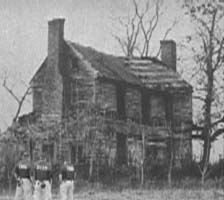

Historical Tales | News | Vampires | Zombies | Werewolves
Virtual Academy | Weapons | Links | Forum
 |
 |
Historical Tales | News | Vampires | Zombies | Werewolves Virtual Academy | Weapons | Links | Forum |
Return to Zombic Biology
While hunting, zombies are all business—but in moments of repose, they show evidence of affection: they will cluster together, rest against each other, even display particular warmth towards child zombies. Furthermore, hunting packs will assemble themselves into approximations of family units, with children, parents and grandparents huddling together.
 |
|
Stage III zombie; 1954 Courtesy: Coroner's Office; Macon County, Georgia |
Hierarchy: There is a distinct pecking order in a zombie pack, although it is much more subtle than that of vampires. Like any pack creature, the strongest and quickest will take the lead in hunting and eat first, and any rival who disrupts their feeding will be dealt with viciously. While vampires often use their cunning to improve their standing in the pack, zombies are relatively guileless, as weaker pack members tend to accept their fate and make the most of the scraps they scavenge. However, they all possess a chilling single-mindedness when it comes to hunting: while vampires have been known to succumb to malnutrition because they lacked the stomach for hunting, there is no such thing as a cowardly zombie.
Hunting: Contrary to popular opinion, zombies are surprisingly observant and fast learners, especially when it comes to hunting. A lone neophyte may stagger mindlessly for a few days, but once it joins a pack its learning curve rises sharply. Since they cannot speak, zombies communicate using gestures and wordless vocalizations. A favorite hunting strategy is to have a few pack members drive prey towards an area where many others are hiding.
The cooperation zombies show in hunting generally vanishes when they start eating, and they can seriously wound one another during a feeding frenzy. Hungry mobs gnaw ravenously to the bone, which they'll crack open to get to the marrow and brains. In times of surplus, the most sated zombies will consume only these nutritious tissues, leaving the rest of the viscera for their weaker subordinates.
 |
|
Photograph of a Stage I zombie in a motel bathroom during the 1960s. Note the ghoulish smile as it stares down the photographer. |
Their voracious appetite begs the question: if zombies consume entire corpses, how do they manage to increase their numbers? Perhaps an outbreak's most important method of expansion lies in a victim's ability to escape after sustaining an infectious injury, along with the fact that zombies—easily triggered by movement—will commonly abandon downed prey to chase after fleeing survivors. There is also some debate as to whether zombies will, like vampires, occasionally seek to increase their numbers. This theory is backed up by the fact that they will sometimes consume only the feet and legs of a victim, leaving everything else mostly intact so the person can survive and transform. Furthermore, when a victim falls into a zombic coma, any zombie that comes across the person will usually leave them alone until they fully turn. If not, only a few bites will be had.
It should come as no surprise that zombies have very limited range. While vampires can move quickly and tirelessly, covering up to 20 miles in one night, a zombie is lucky to cover a few miles in 24 hours. What they do share in common, however, is that a given swath of real estate can only support so many predators. For these reasons, zombism outbreaks tend to be self-regulating: a plague will usually start fast, hit a plateau, then die out quickly as food supply diminishes. On average, they tend to be over within a week or two.
 |
|
Agents looks over the remains of a home in which 24 zombies were found and destroyed. |
For the zombie, home is nothing more than a safe place to rest before the next hunt. Whether holing up in an abandoned building or a fully furnished house, they make no effort at decoration or comfort. As for the finer things in life, zombies do respond to music: a favorite song will cause them to move their bodies in a kind of stiff-limbed dance. They've even been known to embrace each other while silently moving their lips to the lyrics.
Since zombies can go out in the daylight, their choice of hideouts is somewhat more varied than that of a vampire. For example, while the latter must find a cave or construct a crude hovel before the sun rises, a zombie can simply rest against a tree in the woods. However, because they lack the vampire's supreme adaptability, zombies rarely proliferate in urban areas. They do much better in the country, where they can disappear into the landscape.
Hygiene: Unlike vampires, zombies are not sophisticated enough to infiltrate crowds and public places. Thus, there is no need for them to practice personal hygiene. They will wear the same clothing until it's as soiled and tattered as the flesh it covers.
As for mortality and lifespan, the zombie faces an even bleaker prognosis than the vampire: rare is the zombie who lives even one year. The two leading causes of death have always been extermination by zombie hunters, and malnutrition (often due to injuries sustained in fights with other zombies).